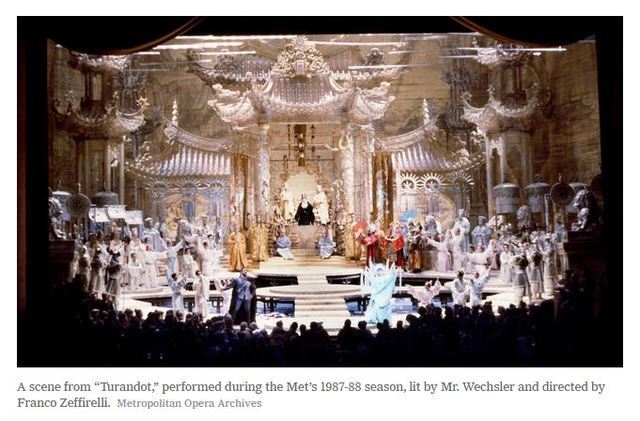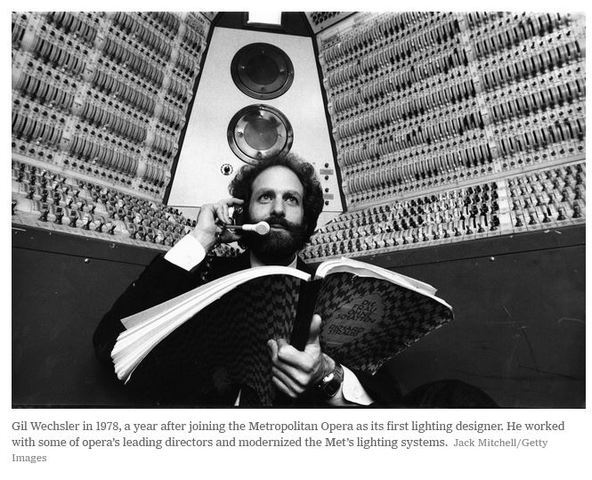Mr. Wechsler, the first resident lighting designer at the Met, created lighting designs that helped bring numerous operas to life.



By Neil Genzlinger
July 20, 2021
Gil Wechsler, who with innovative lighting designs helped bring to life more than 100 productions at the Metropolitan Opera, translating the visions of some of opera’s best-known directors while also contributing to a more modern look for the Met’s stagings, died on July 9 at a memory-care facility in Warrington, Pa. He was 79.
His husband, the artist Douglas Sardo, said the cause was complications of dementia.
Mr. Wechsler was the first resident lighting designer at the Met. He lit his inaugural show in 1977 and, over the next 20 years, made days dawn, rain fall and cities burn in 112 Met productions, 74 of them new.
His career also took him to London, Paris and other international centers of opera and ballet. Wherever he was designing, he knew that audiences often didn’t take much notice of his contributions to a production — which was usually the point.
“If lighting is good, you really shouldn’t notice it often,” he told Opera News in 1987. “In some operas, however, such as ‘Die Walküre,’ the lighting becomes the show. It should seem natural — it shouldn’t jar, but you should be moved by it.”
Fabrizio Melano was among the many directors who appreciated Mr. Wechsler’s skills even though, as he noted, audiences often did not.
“They sort of take the lighting for granted, and it’s something intangible,” Mr. Melano said in a phone interview. “You can see sets, you can see people moving, but lighting is an atmosphere. But sometimes the atmosphere is the most important thing, because so much depends upon it. And he was a master of atmosphere.”
One of many examples of Mr. Wechsler’s handiwork was seen at the Met in Mr. Melano’s staging of Debussy’s “Pelléas et Mélisande,” on which they collaborated in 1977. The set featured a number of scrims and screens, with treelike images projected onto them.
“The illusion of moonlight coming through the trees is created by a patterned slide placed in front of one of the lamps,” The New York Times explained in a 1978 article on Mr. Wechsler and how he created his effects. “From the audience, the set looks remarkably like a three‐dimensional forest.”
Joseph Volpe, a former general manager at the Met, said that Mr. Wechsler was an important part of an effort instituted by John Dexter, the Met’s director of productions from 1975 to 1981, to modernize the look of the company’s productions. Previously, lighting had usually been handled by the head electrician, and the approach was simply to illuminate the whole stage. Mr. Wechsler brought nuance and visual effects into play, including by using light to make a soloist stand out and the chorus fade into shadow.
“The company had a nickname for Gil: Prince of Darkness,” Mr. Volpe said in a phone interview, “because Gil of course understood that it’s important that you don’t flood the whole stage with light.”
Gilbert Dale Wechsler was born on Feb. 5, 1942, in Brooklyn. His father, Arnold, was a stockbroker, and his mother, Miriam (Steinberg) Wechsler, volunteered at the Brooklyn Museum.
When he was growing up his parents often sent him to summer camp in New Jersey, Mr. Sardo said in a phone interview, and working on camp productions is where young Gil first discovered his fascination with theater.
He graduated from Midwood High School in Brooklyn and studied for three years at Rensselaer Polytechnic Institute in Troy, N.Y., before realizing that a career in business or finance was not in his future. In 1964 he earned a theater degree at New York University, and in 1967 he received a master of fine arts degree at Yale.
Upon graduating he found work as an assistant to the prominent set and lighting designer Jo Mielziner, and in 1968 he received his first Broadway credit, as lighting designer on the Charles Dyer play “Staircase.” He would have one more Broadway credit, in 1972, for Georges Feydeau’s “There’s One in Every Marriage.” Before coming to the Met, he also designed for the Stratford Festival in Ontario, the Harkness Ballet, Lyric Opera of Chicago, the Guthrie Theater in Minneapolis and other leading regional theaters and festivals.
At the Met, Mr. Wechsler worked with Otto Schenk, Jean-Pierre Ponnelle, David Hockney and many other leading directors and designers. Lighting for the Met is particularly challenging because — unlike on Broadway, for instance — the shows change on a weekly or even daily basis. One of Mr. Wechsler’s accomplishments, Mr. Sardo said, was to develop accurate records of the lighting schemes for each production, so that one show could be swapped for another more efficiently.
“Before Gil was involved, there were no reference manuals as to how that should be done,” Mr. Sardo said. “Someone kinda remembered how the lighting was supposed to be.”
In 1979, Mr. Volpe said, Mr. Wechsler further smoothed the changeovers by installing the Met’s first computerized light board.
His work on a production began well before opening night or even the first rehearsal; for an opera, he would study an opera’s score and develop his own ideas of how each scene should look.
“The lighting cues are always a function of the music,” he told The Times, “and in that sense, the score is the bible. The music will suggest a sunrise, or a gloomy day perhaps, as well as a feeling of continuity from scene to scene. As I follow the score, certain pictures will automatically occur to me.”
But they were not necessarily the same pictures that occurred to the director or the scenic designer; once they all put their heads together, the compromising would begin. In the Opera News interview, he recalled a particular scene in “Turandot” that he and the director Franco Zeffirelli conceived very differently.
“Puccini’s score doesn’t indicate when the scene is held,” he explained, “except to mention that lanterns are placed around the stage. That clue meant ‘night’ to me, but Franco sees it another way” — he wanted the scene staged in daylight.
Mr. Wechsler also found compromises with the set and costume designers, and with the performers. There was, for instance, the issue of fire.
“Fire is difficult, because you obviously can’t have a full stage fire, even though quite a few operas call for them,” he told The Times. “We create fire with smoke, steam and projections. The more smoke and steam we can use, the better it will look. Unfortunately, the more smoke we use, the less happy the singers are.”
The Prince of Darkness didn’t use shade only to hide the chorus; in the case of some of the Met’s older productions, he used it to keep the wear and tear on the sets from being visible. That could be difficult, though.
“When the score calls for a bright, sunny day, we can’t make it too bright, or you’ll see where the paint is flaking,” he said. “And we can’t make it so dark that it doesn’t look like daytime anymore.”
https://www.nytimes.com/2021/07/20/arts ... -dead.html